The Japanese Pop Album Alyssa Milano Made As A Teenager
by Mike Barthel

Celebrities may cut a vanity single, and some take the time to put together an entire album. But rarely do they get 5-album deals on the strength of their performance in an Arnold Schwarzenegger movie and have several go platinum, only to have those albums sink into obscurity. But that’s what happened to Alyssa Milano in the midst of her run as Tony Danza’s daughter on “Who’s the Boss?” Starting with 1989’s Look in my Heart, she recorded four albums in four years for the Japanese market, and despite their commercial success, she rarely speaks of them today. Is her debut worthy of reconsideration?
THE SONGS: Look in my Heart came out in the waning years of Japan’s “idol” system, in which young singers were paired with professional songwriters and musicians to put out a series of well-crafted singles while the idol’s personality and kawaii-ness were promoted in magazines and television appearances. At the time, the country’s music industry was transitioning to the model of J-Pop, with bands replacing singers as the center of attention (Ian Martin calls 1989 “the death of the idol era”). Milano’s albums though, were produced squarely within the idol system: she was signed on the basis of her looks and personality, and had no role in the creation of the songs. Instead, she flew in and recorded her parts in five days. As a result, the songs sound like what they are, which is Alyssa Milano singing over Japanese pop songs from 1989, though that’s not that different from American pop songs from 1989 — Debbie Gibson’s “Shake Your Love” had come out only two years before, and many songs on Milano’s albums could pass for one of Gibson’s with little modification. There’s even a Tiffany-esque remake of “Da Doo Ron Ron.” None of Gibson’s songs originated as an ad for spaghetti, of course.
THE PACKAGING: Oh, the packaging! The CD comes lovingly accompanied by a booklet full of Milano’s cast-off press photos, the most memorable of which shows her wearing a hockey jersey and severely acid-washed jeans with ripped knees, holding a hockey stick, and sitting next to a very goobery-looking small boy with the same spike haircut my friend Dave had in 1989. The boy is also wearing a hockey jersey but is carrying a soccer ball for some reason. The only contextual explanation for this photo is that it appears next to the lyrics for “Kimi Wa Sunshine Boy,” which translates to “You are my Sunshine Boy,” so maybe the boy is her sunshine boy, since it is sunny out? But it seems weird to think of li’l goober-spikey over there “hold[ing] me tight,” as the lyrics would have it. In another photo, she appears in a straw boater hat, because again, 1989.


In the back of the booklet is an “Alyssa Dictionary” with entries such as “Hobby: Shopping” and “Gooey Chocolate” and “Teen Steam.” The text, which is in Japanese, talks about how Milano is quirky and likeable, saying she tried out for “Annie” as a lark just because she saw a billboard for the auditions, but then she was one of 4 people picked out of 1,500 who tried out. The two entries under “F” are “Fashion” and “Friends.”
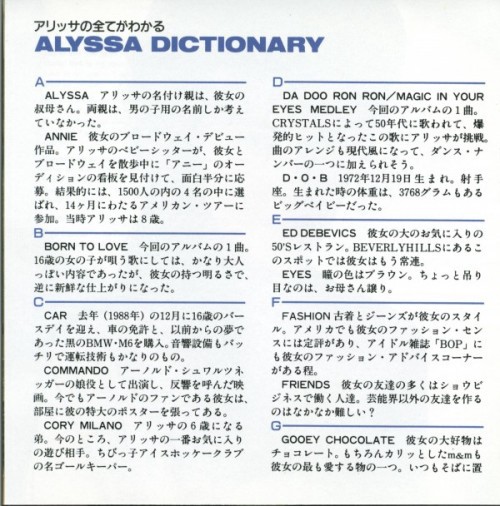
DID IT SELL? For pop albums, this one didn’t do so well, only getting up to #68 on the (Japanese) charts. But since we normally ask this question of vanity projects to assess their commercial viability, the follow-up success of Milano’s next album, which went platinum and hit #15, indicates that this was a solid debut.
CURRENT AVAILABILITY: Out of print. (If you’re reading this outside of Japan, it was technically never in print.)
SKETCHINESS OF LABEL: Nil. Pony Canyon (created by merging two labels and their respective names) is one of Japan’s biggest. They also published the “Ultima” games in Japan, if that’s the kind of thing you find interesting.
WHO HELPED HER MAKE IT: The album is produced and almost entirely written by Joey Carbone, a Brooklyn native who worked his way around the American music business before making a career for himself writing songs for Japanese artists. He was enormously successful at it commercially, and no slouch artistically either — “Tokyo Girl,” above, is some prime-grade bubblegum pop. He also composed the (convincingly Randy Newman-esque) theme song for “It’s Garry Shandling’s Show,” which is entitled “This is the Theme to Garry’s Show.”
WHEN SHE MADE IT: Milano’s had an odd career since the album came out (“Charmed,” starting a website to stamp out fake celebrity nudes, a very successful line of gendered sports apparel, playing Amy Fischer in the third made-for-TV movie about Amy Fisher, “Casualties of Love: The ‘Long Island Lolita’ Story,” maintaining an awesome and eclectic Twitter account), but Look in my Heart came out during the height of her fame as a teen idol. After a role in Old Enough, a 1984 indie film that won a Grand Jury prize at Sundance, she got her big break on “Who’s the Boss.” The show did that 70s/80s sitcom thing of taking a social issue — women’s power in the workplace, in this case — and undermining it completely. Danza, a widower, came to work as a housekeeper for a high-powered female executive played by Judith Light, but doing women’s work makes Danza more feminized, while Light becomes a ball-busting broad. By the final season, when Milano’s character Samantha brings home an aspiring puppeteer with whom she will shortly elope, Light is barking at a Knicks game while Danza admires tiaras. (The show was originally titled “She’s the Boss.”) The show’s success in the teen market led to a series of spinoff opportunities for Milano, most notably the “Teen Steam” VHS, a questionably-titled (and occasionally questionably-contented) workout video for adolescents; it begins with Milano suggesting her two teen friends suffering from imminent teen crises come over and work it out, teen-style. At one point, there is a rap. Her career in Japan, Milano says, was largely the result of her role as Jenny Matrix, daughter of rogue special forces operative Johnny Matrix in Commando, which is remembered today primarily for its GIFs. Despite the fact that Milano spent most of the movie in captivity, the movie sparked enough interest when released in Japan for her to be offered a record contract.
THE MUSIC: Is it time for a Look in my Heart revival? Its sound is not so far off from an electro-pop sound that’s widespread today, from Robyn to the (excellent!) new Tegan and Sara album. Unfortunately, the songs and production are both a bit too generic to sound immediately exciting to modern ears, and too disreputable to sound important to musical antiquarians who don’t already have an interest in Japanese pop. But Milano’s voice is surprisingly fine, a textured alto that occasionally warbles but mostly holds up in a pre-Autotune era. If you’re familiar with any of Milano’s musical output, it’s probably the “Teen Steam” song, but that was arranged to nudge us in the ribs pretty hard about her being a teenager and pitched her voice too high. These songs are more universal (if also generic) and make far better use of her natural vocal qualities. The standout is “You Lied to Me,” whose production tries for Latin pop and ends up sounding a little like an early Knife song. Milano gets to flash a bit of anger, with a spoken-word breakdown where she declares, “You said you needed me, you played me for a fool,” before a rad guitar solo shoves its way in like Steve Vai interrupting a beach party. It’s certainly never going to become a touchstone, but as an unexpected pleasure it fits the bill comfortably.
Previously: Eddie Murphy’s 1980s ‘Party’ Album
Mike Barthel has a Tumblr.
A Poem By David Groff
by Mark Bibbins, Editor
Fire Island Song
It would be nice if you weren’t dead,
you with your hair and skin flame-red
and your way of getting me in bed.
It would be nice if you weren’t dead.
It’s not time’s fault or even fate’s,
though this second claim demands debate:
Too many dead to live, you nearly said.
You savored dread.
You liked where it led.
You let death happen with your
drinks and drugs, your tour
of all the high points of despair.
You were a living cigarette.
You blistered and burned down. You let
me down. This grates.
This isn’t fair,
I say, walking your beach beside myself,
your windy wispy ghost a stealth
seagull full of shit and caw.
You’re also wind. You fuck me raw.
You like where I’m led.
You wanted me to die, you almost said.
The sunset is a scraped-skin red.
I would be nice if you weren’t dead.
David Groff’s new collection of poems, Clay, received the 2012 Louise Bogan Award from Trio House Press.
Let’s all go to the archives, let’s all go to the archives, let’s all go the archives, and get ourselves some poems. You may contact the editor at poems@theawl.com.
Here's a Comedy Sketch Called "CPAC 2013"
What is this? Why, it’s the kickoff to 2013’s Conservative Political Action Conference in National Harbor, Maryland. Why is the nice hostess complaining about the crumbling roads and bridges? And why is the nice hostess mocking America’s War On Terror? Because Barack Obama is president! And you know what happens, etc., such as “Michelle Obama gets Beyoncé.” These themes will be consistent throughout the convention at the Gaylord National Hotel, and tickets sold for as much as $1,000. Next week, when you see endless clips of fresh-faced rising stars of the conservative movement saying insanely racist or just insane things into a microphone on a trade-show stage, this is where it all comes from: CPAC.
This year’s special speakers show just how serious Republicans are about casting out the dangerous lunatics and maybe winning another election someday: Donald Trump, Rick Perry, Mitt Romney, Sarah Palin, Newt Gingrich, Paul Ryan, Michele Bachmann, Rick Santorum, and Rand Paul. Sticking to recent tradition, no electable Republicans (Chris Christie is the only one, we guess?) were invited to appear at the wingnut festival.
But it’s not all reality television millionaires and white people from dubious colleges who come to CPAC to say special things! Each year there is also a Prominent Black Conservative, to show that this is the Party of Lincoln. The very wise Allen West has that role this time around.
Clive Burr, 1957-2013
“I first met Clive when he was leaving Samson and joining Iron Maiden. He was a great guy and a man who really lived his life to the full. Even during the darkest days of his M.S., Clive never lost his sense of humour or irreverence. This is a terribly sad day and all our thoughts are with Mimi and the family.”
— Iron Maiden singer Bruce Dickinson mourns his old drummer Clive Burr, who died Tuesday night after an 18 year battle with multiple sclerosis. Burr played on the band’s first three albums, including their 1982 masterpiece The Number of the Beast. Born in East London, he died at home, in his sleep, at age 56.
Babies Suck Too
“We were surprised — and more than a little chagrined — to find that babies actively prefer individuals who mistreat someone whose tastes differ from theirs.”
— But they do. Because human beings are terrible, even when they are tiny and cute. There’s nothing to do but wait for death to take you.
What Kind Of God Is The God Particle?

“The European Organization for Nuclear Research, or CERN, said that what they found last year was, indeed, a version of what is popularly referred to as the ‘God particle.’ Joe Incandela, who heads one of the two main teams at CERN that each involve several thousand scientists, said in a statement that ‘it is clear that we are dealing with a Higgs boson though we still have a long way to go to know what kind of Higgs boson it is.’”
— Okay, good. Science now says, for SURE, that God exists. Just, in a slightly different form than we, or the new pope, might have expected. It (God) is a class of subatomic particles known as Higgs boson that give mass to the universe. Fascinating and very difficult to think about. (That part, I guess we would have expected God to be like.) No one knows, for example, what kind of God this particle is. Is it a nice, benevolent God, like the one who made the single-day ration of oil stay lit for a full eight days so Jewish children could open eight presents and not feel left out around Christmas time? Is it the cruel, wanton God who treated Job like Google is treating Google Reader users? Is it Thor or Loki from The Avengers
? Is he a she? Like Kali (yikes!) or Aphrodite (now, THAT’S what I’m talkin’ ‘bout!) Does he or she read letters? There are so many different kinds of Higgs boson we could be dealing with. It could be almost anything! Like, what if God was a giant cat? What if God was just a stranger on the bus, trying to make his way home? What if God was like George Burns, but a type of George Burns who gave everything in the universe mass when it passed through the thick haze of cigar smoke that surrounds him at all times? It’s a lot to think about.
Two Men 80
What unites Michael Caine and Quincy Jones? Apart from the possibility that they were both involved in the same movie in one capacity or another, which is a pretty good bet given that they have each had a hand in about a thousand films, they both turn 80 today. Also, Quincy Jones’ middle name is Delight, which I don’t think I ever knew before but now will never forget. Michael Caine, who was born Maurice Joseph Micklewhite, should change his middle name to Delight, both because it would cement the bond and also because Michael Delight Caine sounds awesome. Anyway, best wishes to both, etc.
Richard Hell, Thom Yorke, Renee Fleming
A benefit for the graffiti artist known as ESSAM. Renee Fleming as Blanche DuBois at Carnegie Hall. Atoms for Peace, Thom Yorke’s side project, at Le Poisson Rouge. Ask Roulette at Housing Works — and Richard Hell reads from his memoirs at B&N; Union Square. And even more!
The Future According To 1981: An 'Omni' Appreciation
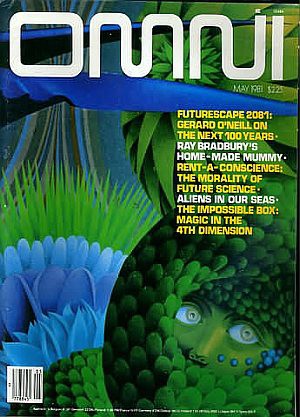
In May of 1981, a draft-dodging ex-pat American published his first story in Omni magazine. The event went largely unremarked. After all, Ronald Reagan was just a few months in office then, and that was either awesome or terrible, depending on your viewpoint, plus that was the same month the Pope got shot! Which is why we now have a Popemobile! But there at your local newsstand, or, if you were lucky (or your parents were generous), there in your mailbox in the plain brown wrapper, William Gibson’s “Johnny Mnemonic” saw print.
And as you may have heard, the Internet Archive has done the world a service by maintaining an online archive of the complete print run of Omni, the beloved science magazine that had a glorious two-decade run from 1978 to 1998. So why not let’s give one particular issue, that Omni May 1981 issue with its Gibson story, a bit of a reread, as it’s just sitting there asking for it. Omni was a magazine about the future. The future is here. Let’s look forward from thirty some years ago.
DEAR PENTHOUSE FORUM, YOU WON’T BELIEVE THIS… BUT UFOS!
At some point, and I reckon this was more towards the middle of high school, I realized that the layout of Omni resembled that of another magazine — Penthouse. There was a reason for that. Omni, launched in 1978, was the brainchild of Kathy Keeton. Keeton, was a South African, trained in ballet, who, in her 20s, became an exotic dancer in Europe (an AP story would later say she’d been one of the highest-paid strippers on the Continent). She met a young Bob Guccione when he noticed her reading the Financial Times between sets. Together they launched their intended competitor to Playboy, Penthouse. Keeton also wanted to start a magazine that was not just a science-fiction magazine, but also a science magazine. Prior to that, sci fi, even though written by men and women with science backgrounds, was often relegated to a more juvenile audience, and even though there was a viable conversation to be had between sci fi and science, that was a marriage the publishing industry had yet to arrange. Speaking of which, Keeton was also the long-time companion (and later wife) of Guccione. Hence, “Editor [later, Editor-in-Chief] and Design Director Bob Guccione” appears at the top of the masthead above the table-of-contents for the run of the magazine. So, why did Omni look like a nudie magazine without any nudes? Because its creator was a former burlesque star/nudie mag executive, and its design director was the second most successful nudie magazine publisher ever. (By the way, Omni went web-only for its last few years, so Keeton was a groundbreaker in more ways than one. She died in 1997, and the website followed her a year later.)
Conveniently, the FIRST WORD section, an editor’s note to start things off, contains something of a mission statement for Omni. It’s written by Executive Editor Ben Bova, a science fiction eminence who started out at Omni as Fiction Editor (after editing Analog for seven years prior to that), and it’s a defense of science fiction as a sort of a strain-testing of science:
Here at Omni, science fiction has been an integral part of our editorial “mix” from the very beginning. Because Omni is “the magazine of tomorrow,” our aim is to examine the future in every way that we can, with feature articles columns of subjects as diverse as television and astronomy, interviews of the world’s leading thinkers — and with science fiction. In fact, science fiction allows us to present dimensions of the future that cannot be seen in any other way.
Bova left the magazine less than a year later. But don’t let’s think that a measure of the quality of this particular issue!
For an 138-page magazine, it is a fat packet of information, with 27 items listed in the table of contents (which do not include the single-panel comics sprinkled throughout). Actually, since the archivists chose to mostly omit full-page ads, we can deduce that it’s a little less than 87 pages of content.
The front of the book alone is a monstrous amount of info, and we haven’t even gotten to the features yet. It’s divided into categories, each a monthly column, with all-caps headings: EARTH, SPACE, LIFE, THE ARTS, EXPLORATIONS and (my favorite) UFO UPDATE. In this issue, there’s a history of the College of the Atlantic, an examination of changes to the human body after extended stays in zero-G environments, a look at the groupthink psychology of U.S. presidential administrations, and more. These are some heady topics to be tackling when the writers could all have been home watching “Dallas.”
The UFO UPDATE in this issue is a little dry, about phenomena in the People’s Republic of China…

… but this installment of THE ARTS is terrific, a profile of up-and-coming director David Cronenberg. “Some part of me would love to make a movie of William Burrough’s Naked Lunch,” says Cronenberg in the lead paragraph. Ominous.
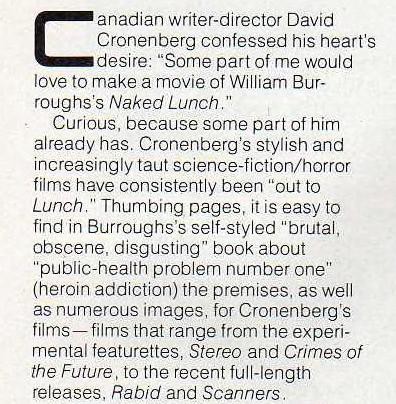
And then this is followed by CONTINUUM, which is the brief-items section, which was also my favorite section, as it was perfectly tailored to my twelve-year-old attention span and appropriately whimsical. Kind of like “That’s Incredible!” Six whole pages of newslets or factoids or whatever you call them: Didja know that the NTSB found a correlation between the whistling of pilots and airplane crashes? Didja know that someone developed a cocoa-based toothpaste? Didja know that Stanford Research Institute posited that WWIII would be fought with computers and not missiles? (Good one, that.) Some of these items are blips, press releases that never made it to proof-of-concept (like the wristwatch rape-prevention device), but still dripping in novelty.
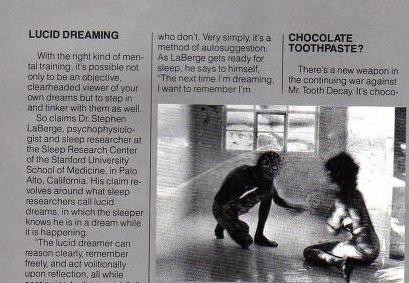
HOW CLOSE ARE WE TO THOSE 2081 PREDICTIONS?

Wading into the features, there’s an essay by Gerard K. O’Neill entitled “2081,” on “five emerging technologies and their impact on society.” It’s not quite 2081 yet, but 32 years seems a safe perspective to see if O’Neill’s predictions are trending in the right direction. O’Neill passed away in 1992 at the age of 65, after a seven-year fight with leukemia. Before that, he was a hard-science futurist from back before futurists were cool. A radar technician in the Navy, he got his doctorate in physics from Cornell and then basically birthed colliding-beam studies, like the CERN particle accelerator that we worry might accidentally create a black hole. He was the founder of the Space Studies Institute, a vocal proponent of space colonization. After he died, Freeman Dyson compared him to Richard Feynman, which is pretty high company.
The five emerging technologies, the “drivers of change,” are computers, automation, space colonies, communications and energy. He nails an amazing amount of it; his predictions on space colonies, though, remain doomed to a more-distant future. (Although there’s still 68 years until his 2081 deadline, and there are certainly some smart/dedicated/wealthy people working on it.) His idea for sustainable energy are interesting — a combination of satellite solar energy, microwaved to earth-bound stations, and thorium “slow” reactors. Of course, those are still both as futuristic now as they were then.
On the remaining three (computers, automation and communications), O’Neill was well on the mark. “Long before 2081 it will be possible to store in a machine the size of a business card all the information of a good sized library,” he writes. What he missed, of course, is that that machine will also be able to communicate with the rest of the world and control the automations in the factories. But the thing about emerging technologies is that they pay no heed to boundaries, and have no compunction against merging with neighboring technologies or morphing in to an entirely new one.
But who knows? Perhaps if O’Neill hadn’t died when he did, I’d be writing this in a slow-reactor powered space station a couple million miles outside the gravity well.
ASK A PROFESSIONAL ETHICIST
The provocatively titled “Rent-A-Conscience,” by Douglas Colligan, concerns the birth of professional ethicists. Colligan identified the two think tanks at the time that were weighing in on the ethical quandaries of the day, such as the first test-tube baby (which caused quite a ruckus at the time) and the right-to-die of Karen Ann Quinlan. “A few years ago, ethical think tanks were dismissed as ivory-tower toys for bored philosophers. But now ethicists are a force.” Prescient! And now even more so, in a world of genetically modified everything and retail gene sequencing.
And even yet more. There’s a charming profile of Jerry Andrus, perhaps the most ethical magician who ever lived, which manages to debunk “mystery spots” as a by-the-way, a story on NASA’s program to put student science experiments on the space shuttle, an in-depth if not wonky interview with Olaf Helmer, the coinventor of the Delphi method, a social forecasting technique that was integral to the nascent field of futurism, and even a bit on the relative intelligence of octopi.
And the images. There are a number of stunning illustrations and photographs: splashes for a feature or short story, a Phenomena photo of autumn clouds (the viewing of which to be improved by a hypnodisc, which you are to cut out and spin on your turntable), the extraterrestrial-vehicle-paintings of Vincent Di Fate, and a pictorial of the spectral photography of Dale Eldred, who is, we were informed obsessed by time. “Not abstract Einsteinian time, but ancient temporal measurement.” Science is never too far away, even in Guccione’s splashy design.

Even the games column, written by Scot Morris, is deliberately braniac, as he devotes a couple hundred words to the history of minimum-information images, landing on Dali’s “Lincoln in Dalivision and the issues surrounding it. The game? Send in your best stab at a minimum information image, readers, and the winner gets a hundred bucks. (The two runners-up get $25 apiece.)
“I’M JOHNNY,” I SAID

But of course, the appeal of Omni at the time (or at least in our memory), is the short fiction that ran, amidst all the science journalism. And this particular issue, maybe a collector’s item for Gibson’s “Johnny Mnemonic,” is actually a very useful snapshot of the forces that were tugging science fiction towards the next century.
The author’s name that appears on the cover is not Gibson; it is Ray Bradbury, who needs no introduction. Bradbury contributes a very very Bradbury story, “Colonel Stonesteel’s Genuine Home-Made Truly Egyptian Mummy.” A lyrical (of course) little affair, a young boy and an older feller in a small Illinois town fighting the “desperate empties” of a slow summer day with a touch of mischief. There’s not much science to this one, nor really any element of the fantastic, other than the prose of Bradbury. It is wistful and nostalgic for a time when bored boys staved off stultification by throwing rocks at the windows of haunted houses. And in fact, it could pass as Bradbury’s secret origin, as the boy, Charlie, tells the Colonel during the sighing final moments of the story: “I made up my mind. I’m going to be the greatest writer that ever lived.”
And if that was not enough of a nod to history, on pages 126 and 127 there’s a “Science Fiction Table of Elements,” with each of the then-103 elements designated as a widely-known science fiction writer of the time.
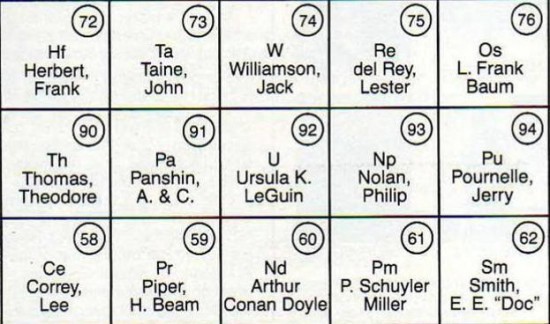
You’re tempted to think that it’s actually ranked hierarchically, as hydrogen is Robert Heinlein and helium is Harlan Ellison, but by the time you get to sodium (Curt Siodmak), you see that it’s more a play on the chemical symbols than anything. But pre-Wikipedia, I’ll bet that a list of 103 science fiction writers would be a majestic thing to which to discover on the next page.
Back to Gibson. He’s not featured on the Table of Elements. On the CONTRIBUTORS page, Gibson is described as “a full-time writer living in Vancouver, British Columbia,” which I’ll bet felt nice to see in print. “Johnny Mnemonic” is prototypical early Gibson, all big ideas and sentences you could cut your finger on, set in an urban dystopia that is impossible not to imagine as the set of “Blade Runner.” It was the dawn of the cyberpunk aesthetic, and “Mnemonic” is as noir as they come, hard-boiled “I dare ya.”
As a fan of both Bradbury and Gibson, it’s nice to revisit these stories in situ, because the conversation they have with each other is the interesting thing. Bradbury’s was set in the past but was aware of the (then) present:
“What do you see out there in the damn town?” the Colonel asked. “Any murders being transacted?”
“Heck, no — “
“Anyone falling off church steeples or being run down by maniac lawn mowers?”
“Nope”
Bradbury is going to write the story he damn well pleases, and if an elbow to Stephen King’s ribs is what it takes to get those kids off his lawn, so be it.
But “Mnemonic,” even though dealing in intentionally nostalgic tropes, is looking solidly somewhere over the horizon:
“…We’re an information economy. They teach you that in school. What they don’t tell you is that it’s impossible to move, to live, to operate at any level without leaving traces, bits, seemingly meaningless fragments of information.”
We may not (yet) live in a world with a leather-pants assassin with mirrored lenses implanted over her eye sockets, or junkie dolphins with super-conducting quantum interference detectors in their brains, but Gibson gets it right. In the margins, in the shadowy edges of the story, where there’s no running or killing or anything, but he gets it right.
Not that Bradbury doesn’t also get it right. But if this particular issue of Omni is a stage, then the opening act just became a tough act to follow
PREDICTION: IN THE FUTURE, EVERYONE WILL BE HARDER TO PLEASE
The Last Word column was written by professional debunker James Randi, who is still with us, in which he hands out his Uri Awards, named after the Isreali magician who convinced the world that he could bend spoons, for instances of gullibility with regards to claims of paranormal science. Think of it a listicle. That year’s winners included the TV show “That’s Incredible!”, notable for its trade in “psychics” with wild “abilities”; Isaac Bashevis Singer, for claiming that he believes in ghosts and dybbuks; and Ronald Reagan for famously claiming to consult with astrologers. Remember astrologers?
It’s an Amazing Randi good read, a shot of grappa to ease digestion, even though I am a staunch proponent of the paranormal, in the interests of keeping the world weird. Which reminds me of something in the profile of the ethical magician Jerry Andrus in the same issue, where the writer notes:
But pure magic, the magic that looks like a real miracle, Andrus-style, is in a strange way antithetical to new technology. As society becomes more technologically sophisticated, we, as an audience, become more suspicious and harder to please.
That’s certainly true now too (and I suspect it was true thirty years before that issue of Omni). But there’s a lot to chew on in this 32-year-old artifact of magazine publishing. Some of it may be outdated, but Omni was a convenient vehicle for understanding the present by trying to figure out what happens next. Who could have predicted how much we’d miss it.
Related: A Timeline Of Future Events
